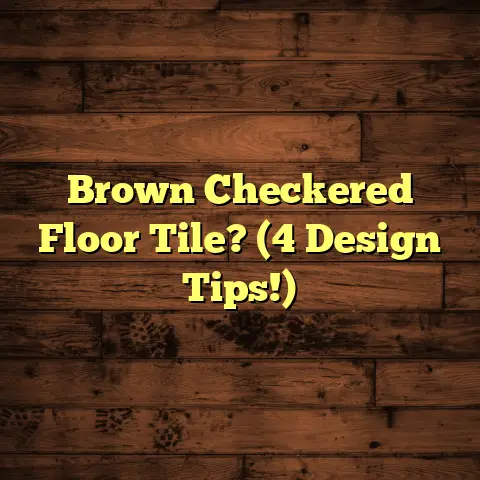Is Lifeproof Vinyl Flooring Good?
Flooring, right? It’s one of those things we don’t think about until we really need to.
But let me tell you, as a flooring contractor for over 15 years, it’s a decision that impacts everything from your home’s value to your daily comfort.
Especially when we’re talking about areas like kitchens, bathrooms, and basements – those moisture magnets that can wreak havoc on the wrong type of floor.
Vinyl flooring has exploded in popularity, and for good reason. It’s versatile, practical, and can mimic the look of hardwood or tile without the hefty price tag.
And Lifeproof? Well, it’s become a household name, synonymous with waterproof and durable vinyl.
But is it really as good as they say?
That’s what we’re diving into today.
I’m going to give you the lowdown on Lifeproof Vinyl Flooring, from its waterproof claims to its overall quality, so you can make an informed decision for your home.
Section 1: Understanding Waterproof Flooring
Okay, let’s start with the basics.
What is waterproof flooring, and how’s it different from water-resistant?
Think of it this way: water-resistant flooring can handle splashes and spills for a short amount of time.
Wipe it up quickly, and you’re good to go.
Waterproof flooring, on the other hand, is impervious to water.
It can withstand prolonged exposure without damage.
This is crucial in areas like bathrooms or basements, where moisture is a constant threat.
So, what makes a floor waterproof? It’s all about the materials and technologies used in its construction.
-
Core Layer: This is the heart of waterproof flooring. Typically made of WPC (wood-plastic composite) or SPC (stone-plastic composite), these cores are dense and don’t absorb water.
-
Surface Treatment: A durable wear layer protects the floor from scratches, stains, and, of course, water. Many waterproof vinyl floors also have a UV coating for added protection.
The benefits of waterproof flooring are pretty clear:
- Easy Cleaning: Spills? No problem. Just wipe them up.
- Mold and Mildew Prevention: Water can’t penetrate, so mold and mildew don’t have a chance to grow.
- Suitable for High-Traffic Areas: Waterproof floors are typically very durable and can withstand heavy use.
Now, let’s talk about Lifeproof.
They’ve built their reputation on these waterproof capabilities. But how do they stack up?
We’ll get into the specifics in the next section.
Section 2: Overview of Lifeproof Vinyl Flooring
Lifeproof is a brand exclusively sold at Home Depot.
It’s become a major player in the flooring market, largely due to its focus on waterproof and durable products.
Think of it as Home Depot’s flagship vinyl flooring brand.
They offer a wide range of styles, colors, and textures, from realistic wood looks to modern tile designs.
You can find Lifeproof in various formats, including planks, tiles, and even sheet vinyl.
Key features of Lifeproof Vinyl Flooring:
- Waterproof: As we’ve discussed, this is their main selling point.
- Durable: Lifeproof is designed to withstand heavy foot traffic and everyday wear and tear.
- Easy Installation: Many Lifeproof products feature a click-lock system, making them relatively easy to install yourself.
Manufacturing Process and Materials:
Lifeproof typically uses a multi-layer construction:
-
Wear Layer: This is the top layer that protects the floor from scratches, stains, and wear. The thickness of this layer is crucial for durability.
-
Decorative Layer: This layer provides the visual appeal, mimicking the look of wood, tile, or stone.
-
Core Layer: This is the waterproof core, typically made of SPC (stone-plastic composite).
-
Attached Underlayment (Optional): Some Lifeproof products come with an attached underlayment for added comfort and sound absorption.
The SPC core is key to Lifeproof’s waterproof properties. It’s made from a blend of limestone and stabilizers, creating a dense and rigid core that won’t absorb water.
This construction makes Lifeproof a solid contender in the waterproof flooring market.
But how does it perform in real-world situations?
Let’s find out.
Section 3: Performance and Durability
Alright, let’s get down to brass tacks.
How does Lifeproof Vinyl Flooring actually perform, especially in those moisture-prone areas we talked about?
From my experience, and from what I’ve gathered from countless customer reviews, Lifeproof holds up pretty well.
I’ve seen it installed in bathrooms, kitchens, and even finished basements that have experienced minor flooding, and it’s come out unscathed.
Lifeproof vs. Traditional Flooring:
-
Hardwood: Hardwood and water? A recipe for disaster. Water can cause hardwood to warp, swell, and rot. Lifeproof, on the other hand, is completely waterproof.
-
Laminate: Laminate is water-resistant, but not waterproof. Prolonged exposure to water can cause the layers to separate and the floor to buckle.
-
Other Vinyl Brands: Not all vinyl is created equal. Some cheaper vinyl options may not have a waterproof core or a durable wear layer, making them susceptible to water damage.
Scratch Resistance:
The wear layer is crucial for scratch resistance.
Lifeproof typically has a pretty decent wear layer, but it’s not indestructible.
Dragging heavy furniture or pets with long nails can still cause scratches.
Here’s a table comparing wear layer thicknesses and their recommended use:
| Wear Layer Thickness (mil) | Recommended Use |
|---|---|
| 6-12 mil | Residential use, low traffic |
| 12-20 mil | Residential use, moderate to high traffic |
| 20+ mil | Commercial use, high traffic |
Dent Resistance:
Lifeproof is more dent-resistant than softer vinyl options, but it’s not immune to dents.
Dropping heavy objects can still leave a mark.
Longevity:
With proper care and maintenance, Lifeproof can last for many years. I’ve seen installations that are still going strong after 10+ years.
Case Studies/Testimonials:
I recently spoke with a homeowner in Atlanta who installed Lifeproof in their basement after experiencing a flood.
They were thrilled with how it held up and said it saved them a lot of money and headaches.
“We were so worried about mold and mildew after the flood,” they told me. “But the Lifeproof flooring didn’t absorb any water, and we were able to clean it up easily. It was a lifesaver!”
Another homeowner I know installed Lifeproof in their kitchen and loves how easy it is to clean.
“With kids and pets, spills are inevitable,” she said. “But I just wipe them up, and the floor looks as good as new. It’s so much easier than dealing with hardwood.”
Overall, Lifeproof performs well in real-world situations, especially when it comes to water resistance and durability.
But it’s important to choose the right wear layer thickness for your needs and to take proper care of the floor to ensure its longevity.
Section 4: Aesthetic Appeal and Variety
Okay, so we know Lifeproof is durable and waterproof.
But let’s be honest, nobody wants a floor that looks like, well, a drab, waterproof box.
Thankfully, Lifeproof offers a wide range of design options to suit various tastes and styles.
Color Choices, Textures, and Patterns:
You can find Lifeproof in a variety of colors, from light and airy neutrals to rich and warm tones.
They also offer different textures, including embossed and hand-scraped finishes, to mimic the look and feel of real wood.
And when it comes to patterns, the possibilities are endless.
You can find Lifeproof that looks like hardwood planks, ceramic tiles, or even natural stone.
Complementing Interior Design Styles:
Lifeproof can complement a wide range of interior design styles:
-
Farmhouse: Opt for a light-colored wood-look plank with a textured finish.
-
Modern: Choose a sleek, gray tile-look with clean lines.
-
Traditional: Go for a rich, warm wood-look with a classic pattern.
Visual Aspects in Flooring Choices:
Flooring is a key element of any interior design scheme.
It sets the tone for the entire space and can impact the overall feel of the room.
Lifeproof balances functionality with style by offering a variety of aesthetically pleasing options that are also durable and waterproof.
Popular Lifeproof Designs:
-
Ocala Oak: A light-colored wood-look plank with a subtle texture.
-
Sterling Oak: A gray wood-look plank with a modern and sophisticated feel.
-
Multi-Width Grey Wood: A multi-tonal grey wood look with high variation.
-
Autumn Wood: A dark brown wood look with a weathered appearance.
-
River Mill: A dark brown wood look with a weathered appearance.
As you can see, Lifeproof offers a wide range of designs to suit various tastes and styles.
Whether you’re looking for a classic wood-look or a modern tile-look, you’re likely to find something that fits your needs.
Section 5: Installation and Maintenance
So, you’ve decided on Lifeproof. Great!
Now, let’s talk about installation and maintenance.
Installation Process:
Many Lifeproof products feature a click-lock system, making them relatively easy to install yourself.
However, there are a few things to keep in mind to ensure a successful installation and to maintain the waterproof benefits:
-
Subfloor Preparation: Make sure your subfloor is clean, level, and dry. Any imperfections in the subfloor can telegraph through the vinyl flooring.
-
Acclimation: Allow the flooring to acclimate to the room’s temperature and humidity for at least 48 hours before installation.
-
Expansion Gaps: Leave a small expansion gap around the perimeter of the room to allow for expansion and contraction due to temperature changes.
-
Proper Tools: Use the right tools for the job, including a tapping block, a rubber mallet, and a utility knife.
DIY vs. Professional Installation:
While many homeowners can successfully install Lifeproof themselves, there are situations where professional installation is recommended:
-
Uneven Subfloor: If your subfloor is significantly uneven, a professional may be needed to level it.
-
Complex Layout: If your room has a complex layout with lots of corners and angles, a professional installer can ensure a clean and professional finish.
-
Warranty Concerns: Some warranties may require professional installation.
Maintenance Tips:
To ensure the waterproof features remain effective over time, follow these maintenance tips:
-
Regular Cleaning: Sweep or vacuum regularly to remove dirt and debris.
-
Damp Mopping: Mop with a damp mop and a mild detergent. Avoid using harsh chemicals or abrasive cleaners.
-
Spill Cleanup: Clean up spills immediately to prevent staining.
-
Protective Mats: Use mats at entrances to trap dirt and moisture.
-
Furniture Pads: Use furniture pads under heavy furniture to prevent scratches and dents.
By following these installation and maintenance tips, you can ensure that your Lifeproof Vinyl Flooring looks great and performs well for many years to come.
Section 6: Cost Analysis
Let’s talk money.
How much does Lifeproof Vinyl Flooring actually cost, and is it worth the investment?
Pricing Compared to Other Flooring Options:
Lifeproof is generally more affordable than hardwood or tile, but it can be more expensive than some cheaper vinyl options.
Here’s a general price range comparison:
| Flooring Type | Price per Square Foot (Installed) |
|---|---|
| Lifeproof Vinyl | \$3 – \$6 |
| Hardwood | \$8 – \$15 |
| Tile | \$8 – \$20 |
| Laminate | \$2 – \$8 |
| Sheet Vinyl | \$1 – \$4 |
Keep in mind that these are just general estimates, and prices can vary depending on the specific product, the location, and the installer.
Warranties and Guarantees:
Lifeproof typically offers a limited lifetime residential warranty, which covers manufacturing defects and wear.
Be sure to read the warranty carefully to understand what is covered and what is not.
Justifying the Investment:
While Lifeproof may be more expensive than some other flooring options, it’s important to consider the long-term value.
The waterproof properties, durability, and ease of maintenance can save you money in the long run by preventing water damage and reducing the need for frequent replacements.
If you’re looking for a flooring option that is both durable and waterproof, Lifeproof is definitely worth considering.
Conclusion
So, is Lifeproof Vinyl Flooring good?
Based on my experience and the feedback I’ve gathered from countless homeowners, I would say yes.
It’s a durable, waterproof, and aesthetically pleasing flooring option that can be a great choice for many homes, especially in moisture-prone areas.
Choosing the right flooring is a big decision.
It’s important to consider both functionality and aesthetic appeal.
Lifeproof balances these two factors by offering a wide range of styles and colors that are also durable and waterproof.
If you’re looking for a reliable and waterproof flooring option, Lifeproof is definitely a strong contender.
Just be sure to do your research, choose the right product for your needs, and follow the installation and maintenance tips to ensure its longevity.
Happy flooring!





